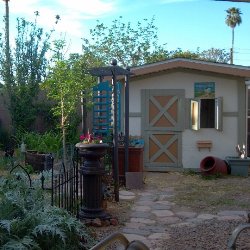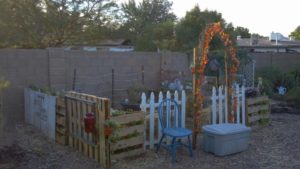What is The Micro Farm Project?
The Micro Farm Project is a beautiful place where veggies, flowers, fruit, and herbs grow and our small livestock animals provide us with fun and food. We are creating a tiny farm on our quarter-acre urban lot and are always experimenting with ways for our family to become more self-reliant and efficient. Our practices are slowly becoming more sustainable, replenishing our little piece of land, our health and our spirits. We invite others to join us and learn step-by-step to create a healthier, more self-sufficient lifestyle.
Our family is on a mission to create a greater connection to our food sources and the things we use by growing and making them ourselves. Life is grand, and we are enjoying the fruits of our labor. What we learn, I teach to others, spreading the good life around.
History of the Micro Farm Project
When my husband and I purchased our pie-shaped lot in the heart of north Phoenix, the backyard was dust and rocks, but we knew it had potential. For several years, when the kids were very small, little was done to improve the yard. Then in 2009, my husband was deployed to serve in the Navy Reserve in the Middle East. To pass the time while he was away, I began to break ground in the yard. Starting on the north side of the patio, I used a large tiller to turn over the mineral dirt and punch through a layer of calcium called ‘caliche’ that ran about two feet under the ground. Good friends helped me to run an irrigation system and turn the desert into my first garden. During a second deployment, I installed two more gardens and a small lawn.
Then I had an epiphany. Looking at an iconic farm scene on a carton of grocery store eggs, I realized that the little farmhouse with the red barn, chickens roaming freely and the sun rising over the green fields as pictured in the scene barely exists anymore and how much I longed for the simple life. I began in earnest to gather knowledge about food production and preservation, composting, how to collect and conserve water, solar cooking practices, and small livestock husbandry. I obtained certification as a Master Gardener and absorbed as much knowledge as I could from books, classes and the internet.
I have included the word “project” in the name of our tiny farm because trial and error have taught me more than anything else. The farm has grown slowly and improvements are made constantly as we learn from experience. Today, our micro farm includes two working compost bins, five gardens that all grow food (as well as pretty flowers,) 5 grape vines, seven fruit trees, a fire pit and solar oven, 20 chickens, 2 Nigerian mini goats, 5 turkeys and 10 Coturnix quail (not to mention a Black Lab and a pet fish.) All of these plants and animals require water, which is scarce in the desert, so we collect air conditioner condensate from our roof and have large wells with French drains around our trees.
Projects that are currently in the works are a solar heat retention oven, a water harvesting and grey-water system, an aquaculture pond and a new goat pen. The adventure continues!
Who Lives at the Farm?
Our little farm is a family endeavor. I have to mention that my husband is a very manly man, and it is a good thing because our farm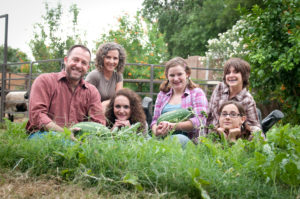 is teaming with estrogen! Of its forty-six inhabitants, six are male (my husband, two turkeys, 2 quail, and one Siamese fighting fish names “namaste.”)
is teaming with estrogen! Of its forty-six inhabitants, six are male (my husband, two turkeys, 2 quail, and one Siamese fighting fish names “namaste.”)
All of these inhabitants make for a lot of work, as well as a ton of fun! Something is always going on around here, whether it be tending to a sick animal, building a new pen, experimenting with a new jam recipe, or the constant cleaning that is necessary to keep our abode a pleasant place to live. We all share a quarter acre, so it is a blessing that we enjoy each others’ company.
Key Components of the Farm
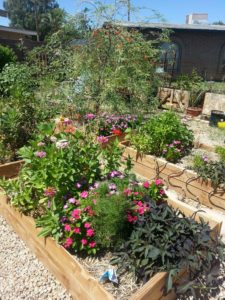 The Gardens
The Gardens
Our property has five gardens that all grow food (six if you include the containers on my patio.) Living in the low desert of Arizona, we have very alkaline mineral soil that contains very little organic matter. Our property also had caliche, which is a layer of calcium that builds up in the soil and can be as hard as concrete. Removing the caliche was the first obstacle that I had to overcome in order to grow healthy plants on my property. Strenuous effort, a heavy-duty tiller and a pick ax accomplished the task.
My next obstacle was overcoming the desert climate and soil conditions to create an oasis in the desert. There is a saying that gardening in Phoenix is easy; all you have to do is make the soil and make the water. This is so true! Before planting, I had an irrigation system installed and plenty of organic matter was added to the native soil. We have two short growing seasons per year. To maintain the soil, at the end of each season, old plants are pulled up and added to the compost pile and finished compost is added to the garden. I also mulch heavily with straw and compost to retain moisture in the soil and add more organic material. After several years of following this routine, I have noticed that the pH has decreased slightly and my soil texture has improved significantly.
I am always experimenting with new crops, but there are a few vegetables and herbs that are grown in my garden year after year. Every day staples, such as herbs, onions of various sorts, potatoes and bell peppers are wonderful to have right outside the door, and save me lots of trips to the grocery store. The tomatoes in our markets are terrible, so I grow plenty of them during the summer and can the excess to use during the winter. We also enjoy growing jalapenos and other types of hot peppers. Squash, eggplant and zucchini are summer staples, as are broccoli, radishes, carrots, cabbage and cauliflower in the winter. Swiss chard and fennel are also cool season regulars. Strawberries, raspberries, and blackberries are perennial favorites to be eaten fresh and for making jam.
This year, I grew Christmas Lima beans and green beans alongside seven rows of corn. The beans fix nitrogen in the soil, which the corn needs an abundance of to grow. In return, the corn acted as a trellis for the beans. Next year, I will add squash to the patch and have a full-fledged “Three Sisters” garden.
Living in Arizona, of course we have cacti in the garden. This particular cactus is a night bloomer. Flowers open after dark and by mid-morning the next day, they wilt and fall. It is very lovely if you can catch it at the right moment.
One of the easiest and most unique items that we grow is a a crop of Christmas Lima beans. A photo of these lovely beans is featured prominently on the cover of “Animal, Vegetable, Miracle,” a wonderful book by Barbara Kingsolver that chronicles her family’s mission to eat only food grown on their property or purchased locally for one year.
Sown in the spring, each Christmas Lima plant produces and abundance of pods. I allow the pods to dry right on the vine, watching carefully to harvest them before they pop open and drop their seeds. When the pods are dried, I remove the entire plant from the garden, cutting the vine into pieces for the compost pile. The pods are split and the beans are removed, to be stored in glass jars through which their lovely colors are visible and their storage is decorative as well as functional. Much like other beans, individual servings are soaked overnight as an addition to soups and various mixed-bean dishes. When served alone, they have a delicious, nutty flavor. A handful of beans is always saved to sow the next season for a new crop. Try them in your garden this summer!
A Fun Book to Read and Christmas Lima Bean Sources
“Animal, Vegetable, Miracle” is an engaging and informative book by Barbara Kingsolver. The story takes the reader on a journey with the author’s family, which has set out on a mission to grow most of their own food and to purchase items that they couldn’t grow from local sources for one year. The account is inspiring, often funny, and sometimes poignantly emotional. I highly recommend this book for those who are interested in a greater connection to and understanding of our food sources, and as an entertaining read for the gardener, environmentalist or foodie.
Di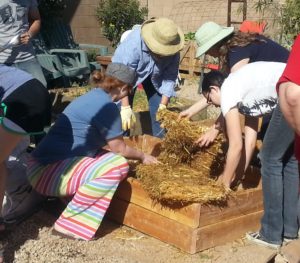 rt School
rt School
Here in Phoenix, AZ, we have three short growing seasons. Like most places, we have a cool season in the fall, a warm season in the spring, and we also have a monsoon season during the summertime. When a friend donated 5 wooden tile crates to the farm, we set them up in the front yard and filled them with soil. The community was invited to join us in planting the gardens and learning how to grow vegetables over an entire growing season. 18 people signed up, and Dirt School was born! The students are learning everything from setting up a garden and irrigation, planting, watering ,feeding, dealing with pests and disease, frost and sun protection, and finally, harvesting!
Th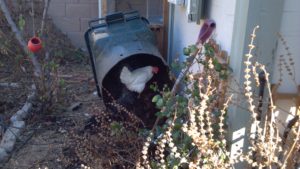 e Compost Piles
e Compost Piles
Compost bins play a central role in a gardening endeavors, providing a sustainable, free source of organic matter and nutrients with which we amend our soil. Garden waste, weeds, and kitchen scraps are added to the compost pile, where they break down into humus. This humus is added to the garden, providing the nutrients to grow more plants. The vegetables and herbs that are grown in the garden are eventually consumed, and the leftover parts of the plants that are not eaten are thrown into the compost pile to continue the cycle. Chickens have a part in this cycle, as well. More on that later.
Two city garbage bins serve as our composters. Each bin has the bottom removed and holes drilled into the sides for aeration. One bin receives new waste material until it is full. It is then set aside to allow bacteria and insects to do the job of composting the pile. Meanwhile, the second bin receives waste until it is full. It is then also set aside to compost. The first bin has finished composting by this time, and it is emptied into the garden and set up to receive fresh waste.
To achieve proper aeration that is necessary for composting, a pile needs to be turned regularly. I am a very small woman, and turning the compost bin can be daunting. In order to make the job easier, I spread a piece of permeable landscape fabric on the ground under the bin. The fabric is then folded up around the bin until it is time to turn the pile, at which time I spread the fabric out and lift the bin off of the top of the pile. A second piece of fabric is spread out next to the first, and the bin is placed on top of it. Using a pitchfork or shovel, the top layer of composting material is returned to the bin. Once the pile is small enough, I use the fabric to lift it and dump it into the bin. If the material is fully composted, I drag the pile to the garden and spread it around.
Because we live in a desert, the compost pile needs to be watered regularly. In order to ensure that the pile will remain moist, a line is run from our automatic irrigation system to the compost bin. Every time the garden gets watered, so does the compost.
Chicke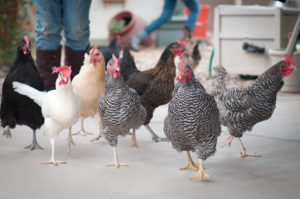 ns
ns
We don’t watch much television; our attention is often captured by the antics of the hens that roam our yard, feasting on bugs and vegetation (including the container plants on my patio.) Their simple lives consist of eating, sleeping, and maintaining their place in the pecking order. The latter provides us with a great deal of amusement. I never knew how mesmerizing poultry could be! From their very first day in the brooder as tiny chicks, we watched as they hopped around, flapping their tiny wings and falling asleep standing up, sometimes falling face first into the feeder when they just couldn’t keep their little eyes open. We cheered them on as they grew and began to fly up to the roosting bar that was placed one foot high in the brooder. On the day that the brooder was placed in the coop with the door open, we waited expectantly for them to venture timidly out into their new home. Now that they are grown, they are our constant companions in the yard.
Each hen has a name and a distinct personality. Sitting on the patio with a cup of coffee in the morning with the chickens roaming the yard is my favorite part of the day and the realization of a key piece of my dream to bring the small farm home.
Hens really put the fun in functional! Besides being friends, the chickens provide some important benefits on our farm. They are wonderful at converting kitchen scraps, weeds and bugs into tasty eggs in all colors: white, brown, tan, pink and even blue. Their waste and bedding are a wonderful addition to the compost, adding both “green” nitrogen and “brown” carbon that are necessary to maintain a healthy pile.
As part of our sustainability plan, the chickens eat plants and bugs in the garden, which they turn into waste and eggs. The waste is added to the compost pile, which eventually feeds the garden so that we are able to grow more healthy vegetables. Eggs are consumed by our family, and the eggshells are crushed and fed back to the chickens. The calcium in the ingested shells ensures that the next batch of eggs will have strong shells. It is never-ending circle that benefits humans, the garden, and the chickens.
Nigerian M ini Dairy Goats
ini Dairy Goats
In 2012, we adopted two Nigerian mini goats. These adorable girls provide fresh milk for our family to drink, as well as to make cheese, soap, fudge, and whatever else we discover that can be made with goat milk. Milking is accomplished by training a goat to stand on a milking platform, at which time they learn that they will receive a treat (which also distracts them during the milking process.) Many people are surprised to find out that we only milk once per day, which, if performed like clockwork, maximizes the amount of milk that the goat will produce (and relieves the goat’s discomfort at having full udders!) One of our goats, Phoenix Rose, is currently pregnant, due in February. The other, Annie Oakley, is a momma. Her doe, Calamity Jane, provides us with all sorts of entertainment!
The goats eat alfalfa hay and sweet feed. We also add some Top Goat feed to provide extra nutrition when they are in milk. I did not realize how much milking took out of them until one of our does started to get shaky on the milk stand. The addition of some added calcium and other minerals has helped her tremendously.
Friends and family came together to help us build a dedicated goat enclosure. We used to keep the goats in the chicken run, but our challenge was to keep them out of the chicken feed, which could upset their stomachs. Now the goats have their own pen, with room to roam! They love to climb, so we have set up some tires and play structures to jump on, including a goat surfboard.
The pen is goat-proof so that they don’t wander the farm and browse the gardens and landscaping. They will eat anything, including the wreath that I had hanging on the fence! But, contrary to popular belief, goats have sensitive stomachs and should be restricted to eating hay, feed and a few occasional treats. Of all things, one of their favorite treats is cornstalks, which don’t break down very easily in the compost pile, so I am more than happy to give them to the goats.
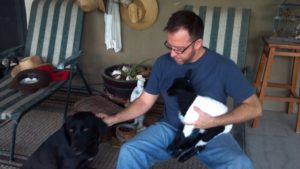 Sheep
Sheep
Through a fortuitous stroke of fate, our farm has acquired a Dorper lamb named Eleanor. A family friend’s daughter received this little beauty as a Christmas present. If you are thinking that a lamb is a strange gift, so thought the child’s mother. She contacted us to ask if we would be willing to adopt the lamb, and even though I knew little about sheep, I couldn’t refuse. The plan was to foster Eleanor until we could find a suitable home amongst our farms-y social network. We picked her up on a cold, December evening and I carried her home in a towel. During that fateful drive home, I fell head over heels in love and I knew that we would find a way to keep her.
No information of any kind was given to us concerning the lamb’s breed, age, or dietary needs. A knowledgeable friend from Wish We Had Acres Farm took a look at her tummy and discovered that the umbilical cord was still attached, indicating that her age was most likely less than one month. We tried to feed her goat milk, the closest alternative to her own mother’s milk that we had on hand, but she refused to drink it. I grew concerned that she was dehydrating. When I found myself home alone on New Year’s Eve, I spent the evening cuddling Eleanor and teaching her to drink from a bowl. At first, she sucked the water right up her nose, but eventually learned to purse her lips and sip noisily, as through a straw. My concern about dehydration was abated, and my thoughts turned to figuring out how and what to feed her. It was the New Year’s holiday, and the feed stores were closed, so I grabbed various types of food from our goat and rabbit supply to test out feeding her.
She refused it all: sweet feed, alfalfa hay, and alfalfa pellets. Meanwhile, I turned the unused goat milk into cheese, and began to add the whey to her water dish so that she would receive a little bit of sustenance. It occurred to me that she only had a few tiny teeth on the bottom of her mouth, and that she would need something soft to chew. I grabbed a handful of rolled oats from the oatmeal jar and held it up to her mouth. She began to eat greedily. Success! She would not starve before I could get to the feed store to buy the appropriate feed for a tiny lamb.
At first, Eleanor was very lonely. As a herd animal, she needed others of her kind. I had hoped that the goats would adopt her, but they instead acted like ill-behaved bullies. Until we acquired another lamb, she was allowed to live in the house with us. Her loneliness was apparent, however, as she followed me everywhere I went and bleated loudly when she couldn’t see me. I quickly came to understand the line in the song “Mary Had a Little Lamb” that says, “Everywhere that Mary went, the lamb was sure to go!” I had a constant shadow and clattering hooves behind me at all times!
After doing some extension research online, I believe that she is a Dorper lamb. This variety is bred for mutton, and can grow as large as 220 pounds. It is hard to believe that our tiny Eleanor will soon be a 200-pounder. Dorpers have hair instead of wool, which is shed in the summer without the need for sheering. I have learned that sheep cannot have copper, which is a necessary element for goats, so they must be housed separately.
A friend for Eleanor
for Eleanor
We found companion for Eleanor, a Blackbelly Ram named Oliver. He is also hair sheep, similar to Dorpers. Both kinds of sheep are mutton sheep, and from what I have read they can be crossbred, so that is our plan!
He was five days old when we got him, so he needed to be trained to drink from a bottle. This was a real challenge! We were unsuccessful in training Eleanor, but luckily, she learned to drink from a bowl very quickly. Thankfully, Oliver got the hang of it quickly so that he was able to get the nourishment that he needed from the goat milk that we fed to him.
As the goats matured, we had to separate them into their own pens to prevent Eleanor from becoming pregnant too soon. The two pens are adjoined, however, so that they can see each other and touch through the fence.
This is Oliver, all grown up! He is a very friendly fellow who comes to the fence for a scratch when we are nearby. Despite his sunny disposition, we observe one rule at all times, which is ‘never turn your back on a ram.’ His instinct is to butt, which he does with gusto! Although he typically butts his water pail and the toys that we give him, and has never butted a family member, we are cautious due to his large size and manly horns!
 Turkeys
Turkeys
Turkeys are temporary visitors to our farm. Unlike the hens, these birds are raised for meat. Though they are friendly and we enjoy them while they inhabit our yard, we try not to become too attached as their stay will only be four to six months long. The children can’t resist naming them, though they are encouraged not to give them endearing monikers. Their namesakes are villains in history or literature, or the names of food, such as Sammy (short for sandwich.) The turkeys are larger and messier than the chickens, and they prefer to be near us, on the porch and the patio furniture. They consume a lot of feed, even after eating grass and garden plants all day long. Within a few months, they grow from a couple of ounces to between 25 and 40 pounds! Having fresh turkey for the holidays is definitely worth the trouble to raise them. Additionally, like the chickens, their waste becomes part of the compost pile. and they help to keep the pest population under control in the gardens.
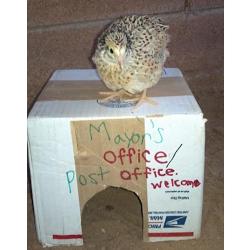 Coturnix Quail
Coturnix Quail
We currently have eleven Coturnix quail, also known as Japanese or Bible quail. These docile little birds produce an average of an egg each day in exchange for very little feed. The eggs are lovely, delicious, healthy and about a quarter of the size of a large chicken egg. We recently purchased an incubator and will attempt to hatch a few eggs to expand our little flock.
Our plan is to increase the numbers sufficiently enough to obtain meat from the quail. While I don’t relish the idea of processing the birds, I look forward to having a renewable source of meat on our farm.
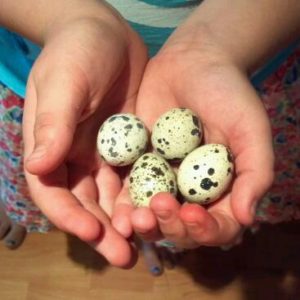 Quail eggs are small, but mighty!
Quail eggs are small, but mighty!
Benefits of Quail Eggs
- Nutrition 4X higher than chicken eggs
- 5X the iron & potassium
- Packed with calcium, protein, A & B vitamins
- No “bad” cholesterol (LDL)
- High in “good” cholesterol (HDL)
- Do not cause allergies (for people who are allergic to chicken eggs)
- It takes less feed to produce a pound of quail eggs than a pound of chicken eggs
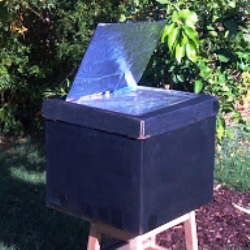 Solar Oven
Solar Oven
Arizona is a leader in the solar power industry, and you can imagine why. Here in Phoenix, we average 325 sunny days per year! To save energy (and the money spent on our electric bill,) we harness the power of the sun to cook a good portion of our meals. Solar cooking has many advantages. It is environmentally benign and cooks food at a lower, healthier temperature. It does not heat up the kitchen in the summer and is very easy to use, working much like a slow cooker. Currently we use a portable solar box cooker, but have plans in the works to build a permanent heat retention solar oven.
A solar box cooker is very simple to make using items that you may already have around the house. To learn more about constructing and using a solar cooker, download an informative PDF booklet at http://solarcooking.org/plans.
How to Make, Use and Enjoy Solar Cookers
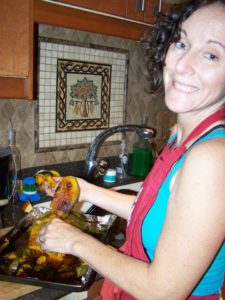 The Kitchen
The Kitchen
The kitchen is the hub of our household, the place where meals are enjoyed, projects are made, and the harvest is preserved. We have a lovely six-and-a-half foot farm table that does double duty as a dining set and workspace. Since we are unable to have a root cellar in the desert, we store the harvest in a commercial fridge and two freezers During the summer months, tomatoes and fruits are canned, garlic and onions are braided, and herbs are dried for storage in the pantry.
Throughout the year, vegetables are blanched, packaged using our Food Saver vacuum sealer, and frozen. The Food Saver has been a wonderful addition to our kitchen. Vegetables stored using the vacuum sealer stay fresh in the freezer for a very long time, retaining their original color, texture and flavor. And it is much easier to use than the pressure canner!
Straw Bale & Pallet Garden
This year, after the turkeys were “processed,” we removed the turkey pen and cleared the ground underneath it to create a new garden. I figured that the turkeys had been fertilizing the soil all summer, so why not make use of it? Around the garden, I built walls with straw bales, which I covered with compost. I then built a second wall out of wooden pallets, and filled the pallets with soil and compost. After running a drip irrigation system all the way around the garden, food and flowers were planted in the ground, the straw, and the pallets. During the winter months, we will grow cool season vegetables in this garden. Then, in the spring, we will tear down the garden, throw the straw in the compost bins or use it as mulch, and set the turkey pen back up for our next batch of birds. For now, it’s a pretty addition to our farm.
Tour de Coops 2012
This year our farm was featured on the Fourth Annual Tour de Coops, organized by volunteers of the Valley Permaculture Alliance. The tour was created in response to the growing interest in urban livestock. On the day of the tour, the farm had approximately 300 visitors, and our family had lots of fun giving tours of the property and answering questions about our livestock, solar ovens, gardens and so forth. For more information about Tour de Coops and general info about urban chickens, click on the banner.
We are enjoying the journey to greater self-reliance and the creation of our Micro Farm. I hope that you enjoyed reading our story, and are inspired to grow something of your own! Use the comments section below to tell me about your own projects or to ask me questions. Read our lenses to learn about how we take care of our chickens, preserve the harvest and run our farm. Thank you for taking the time to visit us!
